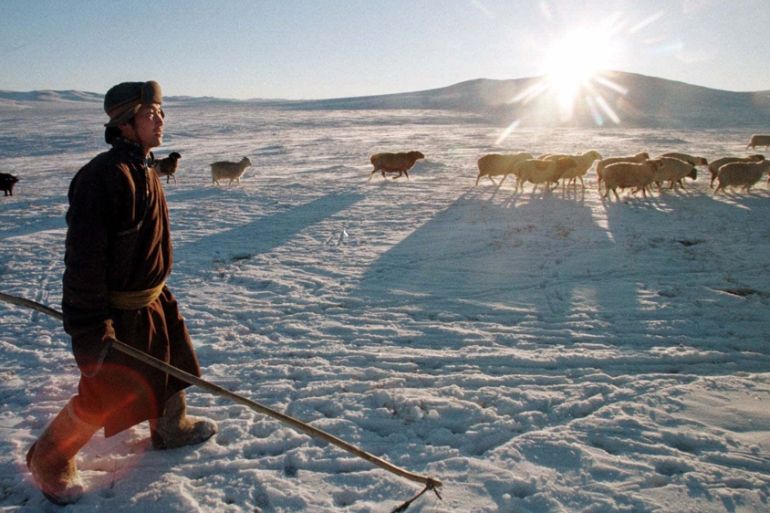
Mongolia: The nomads risking it all
Mongolian herders shift their entire lives across frozen rivers and through 2,000 metre-high mountain passes.
Editor’s note: This film is no longer available online.
“We’re the generation that’s been abandoned since the end of communism.”
Keep reading
list of 4 itemsAfter the Hurricane
World’s coral reefs face global bleaching crisis
Why is Germany maintaining economic ties with China?
Like many other former gold and jade hunters in Mongolia, Lagva is struggling to make a living since mines across the country have been shut down.
Lagva is sitting on a treasure – owning jade stones worth between $14,000 and $19,000 – but he has yet to receive permission to sell the precious stones.
| Mongolia’s nomads |
|
* Mongolia’s vast steppe is home to one of the world’s last surviving nomadic cultures.
* One in three Mongolians are nomads and many of them live in often-inhospitable regions.
* Every spring, the nomadic families drive their herds across the steppes to fresh pastures.
* They take almost hundreds of animals and all their worldly goods on a risky journey.
* The herds live off the land, and the nomads live off the milk and meat of their animals.
|
“I hide the stones in the basement; it’s where we used to hang the meat before”, says Lagva.
While waiting for the government’s permission, Lagva scrapes a living, renting his small, 35-year-old truck to nomadic herdsmen.
Mongolia’s vast steppe is home to one of the world’s last surviving nomadic cultures. Herding is a way of life for over a third of Mongolians, with many of the nomads living in often-inhospitable regions.
The Darkhad (craftsmen) nomads are some of the world’s most self-sufficient people, leading a gruelling life in the north of Mongolia. The herds live off the land, and the nomads live off the milk and meat of their animals.
Their life revolves around finding pasture for the herds, and every spring, in the region of Lake Khovsgol, Minjbayar and his family take almost 250 animals – sheep, goats, yaks – and all their worldly goods on a risky journey.
During the so-called transhumance, entire families play a game of chance with their animals and their health, as they cross iced rivers and travel on narrow roads at an altitude of 2,000 metres. In the icy mountains, the temperature can reach -40C and there is always the threat of wolves attacking the herd.
“The transhumance will take four or five days. It’s long and strenuous, but we can’t stay here. There’s no snow this year. I think it’s because of climate change. There’s less water, and there will be a drought later on. So there’ll be less grass. Since that’s what the animals eat, they could be at risk,” explains 20-year-old Aza.
The way of life for nomadic herdsmen on the plains of Mongolia has changed little in centuries and life has always been challenging.
“My father was a herdsman”, says 60-year-old Minjbayar. “In those days he led his herds towards the USSR. I went along on these journeys from a very young age. Sometimes there were as many as 1,400 animals to move along. There was some really bad weather. We’d sometimes lose our cattle, and they would die of cold or because of the storms.”
But while Minjbayar and his family continue to brave the transhumance and Mongolia’s extreme weather each year, other nomads have taken a different route in their attempt to find a better life for themselves, nearer to the city.
In the past three decades, around 600,000 former herders have migrated to the Mongolian capital Ulaanbaatar – mainly due to the end of Soviet state support and climate change.
Increasingly dry summers have made it harder to grow and harvest grass for the herds, so the animals cannot put on enough weight to survive the winter cold.
More than one million animals died during last year’s dzud, a Mongolian term for a severe winter. The 2009-2010 dzud killed about eight million animals in Mongolia, putting the livelihoods of thousands of nomads under threat as well as harming the country’s food supply.
If their livestock die during the harsh winters, herders are often forced to move to the city to survive. Many families who live in remote areas also head to the capital in search of better education for their children.
|
|
“I’ve never been to Ulaanbaatar”, says Aza, “But I’d like to go to see what a city’s like. I’ll definitely send my child there to study. I don’t want him to be a herdsman. It’s too tough.”
In response to the deteriorating situation, Mongolia’s National Emergency Management Agency partnered with the UN development programme and NGOs to support Mongolia’s struggling nomads.
In January 2017, the UN announced that it has allocated $1.1m to help herders access essential items such as food, fuel and basic medications by providing cash grants as well as animal feed packages and veterinary first aid kits to minimise the loss of livestock as their main source of food and income.